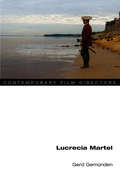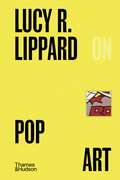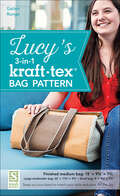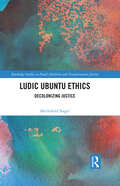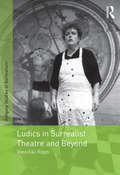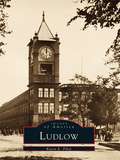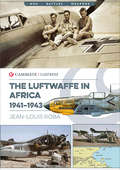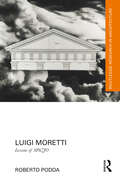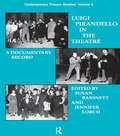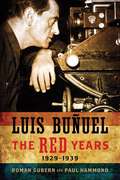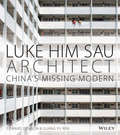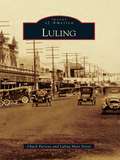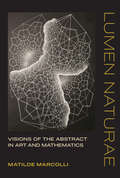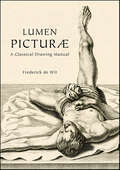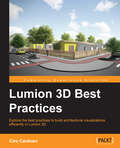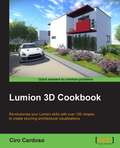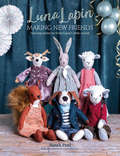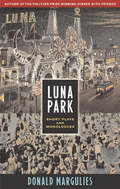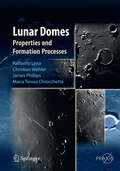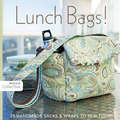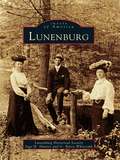- Table View
- List View
Lucrecia Martel (Contemporary Film Directors)
by Gerd GemündenFilms like Zama and The Headless Woman have made Lucrecia Martel a fixture on festival marquees and critic's best lists. Though often allied with mainstream figures and genre frameworks, Martel works within art cinema, and since her 2001 debut The Swamp she has become one of international film's most acclaimed auteurs.Gerd Gemünden offers a career-spanning analysis of a filmmaker dedicated to revealing the ephemeral, fortuitous, and endless variety of human experience. Martel's focus on sound, touch, taste, and smell challenge film's usual emphasis on what a viewer sees. By merging of these and other experimental techniques with heightened realism, she invites audiences into film narratives at once unresolved, truncated, and elliptical. Gemünden aligns Martel's filmmaking methods with the work of other international directors who criticize—and pointedly circumvent—the high-velocity speeds of today's cinematic storytelling. He also explores how Martel's radical political critique forces viewers to rethink entitlement, race, class, and exploitation of indigenous peoples within Argentinian society and beyond.
Lucy R. Lippard on Pop Art (Pocket Perspectives #0)
by Lucy LippardExplore the dynamic world of 1960s pop art through Lucy Lippard's insightful analysis of this groundbreaking international art movement. Surprising, questioning, challenging, enriching: the Pocket Perspectives series presents timeless works by writers and thinkers who have shaped the conversation across the arts, visual culture, and history. Celebrating the undiminished vitality of their ideas today, these covetable and collectable little books embody the best of Thames & Hudson.
Lucy's 3-in-1 kraft-tex Bag Pattern
by Gailen Runge1 pattern, 3 sizes, unlimited possibilities This versatile and stylish bag comes in three sizes: small, medium, and large weekender—perfect for those overnight trips (fits carry-on luggage requirements)! Play with 2 different colors of kraft-tex and customize the interchangeable band with outside zipper pockets, inside passport pockets, and even knitting needle holders! Or add elastic straps and use the band by itself to carry your yoga mat or picnic blanket. The clever zipper treatment allows each of the three bags to open wide, making finding your necessities a breeze. Includes advice and tips on sewing and handling kraft-tex. • Mix and match your bands to customize your look and use (small and medium bags use the same size band!) • Experiment with kraft-tex, a popular new substrate that all accessory sewists are talking about! • Carry heavy loads without tearing—unique band construction is both lightweight and sturdy • Finished medium bag 15" x 9 1/2" x 7 3/4"; large weekender bag 22" x 11 3/4" x 9 1/2"; small bag 9" x 9 1/2" x 7 3/4"
Ludic Ubuntu Ethics: Decolonizing Justice (Routledge Studies in Penal Abolition and Transformative Justice)
by Mechthild NagelLudic Ubuntu Ethics develops a positive peace vision, taking a bold look at African and Indigenous justice practices and proposes new relational justice models. ‘Ubuntu’ signifies shared humanity, presenting us a sociocentric perspective of life that is immensely helpful in rethinking the relation of offender and victim. In this book, Nagel introduces a new theoretical liberation model—ludic Ubuntu ethics—to showcase five different justice conceptions through a psychosocial lens, allowing for a contrasting analysis of negative Ubuntu (eg., through shaming and separation) towards positive Ubuntu (eg., mediation, healing circles, and practices that no longer rely on punishment). Providing a novel perspective on penal abolitionism, the volume draws on precolonial (pre-carceral) Indigenous justice perspectives and Black feminism, using discourse analysis and a constructivist approach to justice theory. Nagel also introduces readers to a post secular turn by taking seriously the spiritual dimensions of healing from harm and highlighting the community’s response. Spanning disciplinary boundaries and aimed at readers seeking to understand how to move beyond reintegrative shaming and restorative justice theories, the volume will engage scholars of criminology, philosophy and law, and more specifically penal abolitionism, social ethics, peace studies, African studies, critical legal studies, and human rights. It will also be of great interest to practitioners and activists in restorative justice, mediation, social work, and performance studies.
Ludics in Surrealist Theatre and Beyond (Studies in Surrealism)
by Vassiliki RaptiTaking as its point of departure the complex question about whether Surrealist theatre exists, this book re-examines the much misunderstood artistic medium of theatre within Surrealism, especially when compared to poetry and painting. This study reconsiders Surrealist theatre specifically from the perspective of ludics-a poetics of play and games-an ideal approach to the Surrealists, whose games blur the boundaries between the 'playful' and the 'serious.' Vassiliki Rapti's aims are threefold: first, to demystify André Breton's controversial attitude toward theatre; second, to do justice to Surrealist theatre, by highlighting the unique character that derives from its inherent element of play; and finally, to trace the impact of Surrealist theatre in areas far beyond its generally acknowledged influence on the Theatre of the Absurd-an impact being felt even on the contemporary world stage. Beginning with the Surrealists' 'one-into-another' game and its illustration of Breton's ludic dramatic theory, Rapti then examines the traces of this kind of game in the works of a wide variety of Surrealist and Post-Surrealist playwrights and stage directors, from several different countries, and from the 1920s to the present: Roger Vitrac, Antonin Artaud, Günter Berghaus, Nanos Valaoritis, Robert Wilson, and Megan Terry.
Ludlow (Images of America)
by Karen E. PilonIncorporated on February 28, 1774, Ludlow, Massachusetts, was originally a part of Springfield. The origin of the name remains a mystery, though the most probable explanation is that it was named afterRoger Ludlow, an early prominent New England citizen who played a great part in building up the town and taking care of its citizens. The Ludlow Manufacturing Company, formed around 1900 by Charles T. Hubbard, helped shape the town by providing housing, a library, schools, playgrounds, and even a clubhouse for the diverse community. Ludlow was home to many sawmills and gristmills, utilizing the power from the several sources of water nearby, including the Chicopee River, Broad Brook, Higher Brook, and Stony Brook. The town is most noted, however, for its factory mills and production of jute yarns, twine, and webbing. Less well known was the glass-making business that was prevalent in the early 1800s. John Sikes manufactured glass bottles andother glassware and the Ludlow Manufacturing Company glass works operated for only a short time before closing in the depression years following the War of 1812. Today, Ludlow remains a culturally diversecommunity made up of Portuguese, Polish, French, and Irish residents, just to name a few.
Luftwaffe in Africa, 1941–1943 (Casemate Illustrated #Cis0015)
by Jean-Louis RobaThis WWII history examines Nazi air force operations in Egypt and Libya with more than 100 rare wartime photographs. When Mussolini&’s army was defeated on the Libyan-Egyptian border at the beginning of 1941, Adolph Hitler had no choice but to send reinforcements to help his ally. The Luftwaffe deployed an air detachment, first to Sicily, then to North Africa. This volume examines the small expeditionary force, solely devoted to protecting Italian possessions in the Mediterranean and Middle Eastern theater. When General Erwin Rommel launched his Afrika Korps to the east, the Luftwaffe had to go on the offensive to cover the advance. As British air forces were strengthened, German High Command was obliged to send more aerial units into what it had initially considered a peripheral arena of the war. Losses in bombers and fighters were high on both sides. By the time the Allies landed in Morocco and Algeria at the end of 1942, the Wehrmacht&’s fate was sealed. The last German units capitulated in Tunisia in May 1943.
Luigi Moretti: Lessons of SPAZIO (Routledge Research in Architecture)
by Roberto PoddaLuigi Moretti: Lessons of SPAZIO focuses on the theoretical work of the Italian architect Luigi Moretti (Rome, 1906–1973). It does so selectively, focusing on the editorials he published between 1950 and 1953 as editor-in-chief of the magazine SPAZIO, as well as a further essay on parametric architecture, published in 1971–1972, in the first issue of the magazine MOEBIUS, directed by his friend Giulio Roisecco.This book rediscovers Moretti's personal impact on international architectural theory through thoughtful comments that shed light on the architect's modernity and original approach. Although Moretti is an architect renowned for his projects and buildings, his theoretical essays are less well-known. The aim of this book is therefore to explore Moretti's theoretical work, which covers many topics, including pictorial art, sculpture, architecture, urban planning, music, cinema, poetry, mathematics, computer science, parametricity. In addition to the translation from Italian to English, the book contains reproductions of the original articles, accompanied by a series of essays of critical commentary and updated interpretations that show new ways of approaching, reading, and understanding the foundations of current architectural theory and its progress over the last 50 years. This book approaches Moretti's thought from a new perspective, with the aim of reconsidering the originality of this brilliant and visionary architect who was intellectually ostracised for many years due to political and ideological contingencies, even though he personified the ideal of the 'Renaissance man' in modern times.A re-reading of Moretti's work is more justified today than has ever been before, both to reconnect the threads with contemporaneity and to make his intensity and farsightedness of vision known to researchers, teachers, and students working in the areas of architecture and design theory, technology, and art today.
Luigi Pirandello in the Theatre
by Susan Bassnett Jennifer LorchFirst Published in 1993. Routledge is an imprint of Taylor & Francis, an informa company.
Luis Frois: First Western Accounts of Japan's Gardens, Cities and Landscapes
by Cristina Castel-Branco Guida CarvalhoThis book focuses on Luis Frois, a 16th-century Portuguese Jesuit and chronicler, who recorded his impressions of Japanese gardens, cities and building practices, tea-drinking rituals, Japan’s unification efforts, cultural traditions, and the many differences between Europe and Japan in remarkable manuscripts almost lost to time. This research also draws on other Portuguese descriptions from contemporary sources spanning the years 1543 – 1597, later validated by Japanese history and iconography. Importantly, explorer Jorge Alvares recorded his experiences of discovery, prompting St. Francis Xavier to visit Japan in 1549, thus ushering in the “Christian Century” in Japan.During this long period of accord and reciprocal curiosity, the Portuguese wrote in excess of 1500 pages of letters to European Jesuits that detail their impressions of the island nation—not to mention their observations of powerful public figures such as Oda Nobunaga, Toyotomi Hideyoshi, and Sen no Rikyu. In addition to examining these letters, the authors translated and researched early descriptions of 23 gardens in Kyoto and Nara and 9 important cities—later visited by the authors, sketched, photographed and compared with the imagery painted on 16th-century Japanese screens.However, the data gathered for this project was found mainly within five large volumes of Frois’ História do Japão (2500 pages) and his Treaty on Contradictions—two incomparable anthropological works that were unpublished until the mid-20th century for reasons detailed herein. His volumes continue to be explored for their insightful observations of places, cultural practices, and the formidable historical figures with whom he interacted.Thus, this book examines the world’s first globalization efforts that resulted in profitable commerce, the introduction of Portuguese firearms that changed Japan’s history, scientific advances, religious expansion, and many artistic exchanges that have endured the centuries.
Luis Valdez (Routledge Performance Practitioners)
by Ricardo Rocha Jorge A. Huerta Guillermo Avilés-Rodríguez Karina Gutiérrez Jade Power-SotomayorLuis Valdez studies the life and work of this Chicano playwright, director, performer, and producer along with the implications of his legacy for Chicana/o/x communities and for all who engage with his work.Valdez’s work broadened the scope of theater and arts in the Chicano community, and his formation of El Teatro Campesino brought together students and farmworkers. This volume highlights his professional work and writings. It offers a unique investigation of Luis Valdez, his life, his oeuvre, and his contributions to the theater in the United States and beyond. This book combines: an in-depth biographical overview of Valdez’s life and career, focusing on defining experiences that set his trajectory into motion; an exploration of Valdez’s key writings—the 1973 epic poem Pensamiento Serpentino and the unpublished lecture The Power of Zero which articulate his philosophy of the Theatre of the Sphere; a stylistic analysis of his key works, including Soldado Razo and Zoot Suit as well as their critical reception; and a selection of improvisation and dance-based warm-ups, embodiment exercises, and an acto writing practicum adapted to experiment with Valdez’s works. As a first step towards critical understanding, and as an initial exploration before going on to further, primary research, Routledge Performance Practitioners offer unbeatable value for today’s students.
Luke Him Sau, Architect
by Edward Denison Guang Yu RenLuke Him Sau/Lu Qianshou (1904-1991) is best known internationally and in China as the architect of the iconic Bank of China Headquarters in Shanghai. One of the first Chinese students to be trained at the Architectural Association in London in the late 1920s, Luke's long, prolific and highly successful career in China and Hong Kong offers unique insights into an extraordinary period of Chinese political turbulence that scuppered the professional prospects and historical recognition of so many of his colleagues.Global interest in China has risen exponentially in recent times, creating an appetite for the country's history and culture. This book satiates this by providing a highly engaging and visual account of China's 20th-century architecture through the lens of one of the country's most distinguished yet overlooked designers. It features over 250 new colour photographs by Edward Denison of Luke's buildings and original archive material.The book charts Luke's life and work, commencing with his childhood in colonial Hong Kong and his apprenticeship with a British architectural firm before focusing on his education at the Architectural Association (1927-30). In London, Luke was offered the post of Head of the Architecture Department at the newly established Bank of China, where IM Pei's father was a senior figure. Luke spent the next seven years in the inimitable city of Shanghai designing buildings all over China for the Bank before the Japanese invasion in 1937 forced him, and countless others, to flee to the proxy wartime capital of Chongqing. In 1945 he returned to Shanghai where he formed a partnership with four other Chinese graduates of UK universities; but civil war (between the Communists and Nationalists) once again caused him and others to uproot in 1949. Initially intent on fleeing with the Nationalists to Taiwan, Luke was almost convinced to stay in Communist China but decided finally to move to Hong Kong. There, for the third time in his life, he had to establish his career all over again. Despite many challenges, he eventually prospered, becoming a pioneer in the design of private residences, schools, hospitals, chapels and public housing.
Luling (Images of America)
by Luling Main StreetOne historian described Luling in the 1870s as "the toughest town in Texas." Along with the railroad came notorious gamblers who were ready to take a man's hard-earned money any way they could. But when settlers enforced what laws there were and established permanent homes, churches, and a school, the rougher crowd sought greener pastures. In the southern corner of Caldwell County, Luling had at first an agrarian-based economy, but that changed with the discovery of oil, which boosted the population from a few hundred residents to several thousand. The oil industry and related businesses kept the population steady. Luling soil also proved beneficial to crops such as cotton, but the area's prize crop became watermelons. Today oil and watermelons keep Luling on the map, and the annual Watermelon Thump attracts thousands. At the crossroads of three important highways, businesses flourish, especially barbecue, which is considered by some to be the best in the state.
Lumen Naturae: Visions of the Abstract in Art and Mathematics
by Matilde MarcolliExploring common themes in modern art, mathematics, and science, including the concept of space, the notion of randomness, and the shape of the cosmos.This is a book about art—and a book about mathematics and physics. In Lumen Naturae (the title refers to a purely immanent, non-supernatural form of enlightenment), mathematical physicist Matilde Marcolli explores common themes in modern art and modern science—the concept of space, the notion of randomness, the shape of the cosmos, and other puzzles of the universe—while mapping convergences with the work of such artists as Paul Cezanne, Mark Rothko, Sol LeWitt, and Lee Krasner. Her account, focusing on questions she has investigated in her own scientific work, is illustrated by more than two hundred color images of artworks by modern and contemporary artists. Thus Marcolli finds in still life paintings broad and deep philosophical reflections on space and time, and connects notions of space in mathematics to works by Paul Klee, Salvador Dalí, and others. She considers the relation of entropy and art and how notions of entropy have been expressed by such artists as Hans Arp and Fernand Léger; and traces the evolution of randomness as a mode of artistic expression. She analyzes the relation between graphical illustration and scientific text, and offers her own watercolor-decorated mathematical notebooks. Throughout, she balances discussions of science with explorations of art, using one to inform the other. (She employs some formal notation, which can easily be skipped by general readers.) Marcolli is not simply explaining art to scientists and science to artists; she charts unexpected interdependencies that illuminate the universe.
Lumen Picturae: A Classical Drawing Manuel
by Frederick de WitLumenPicturaeis apictorial guide to classicaldrawing as exemplified by the sublime work of the influential 17th centuryDutch engraver Frederick de Wit. Presenting a carefully curated set of imagesnever before seen outside of rare book archives, Lumen Picturaerenders de Wits’ incomparable figure drawings available to the public forthe first time. In the tradition of Harold Speed’s The Practice and Scienceof Drawing, Andrew Loomis’s Figure Drawing for All It’s Worth,Gottfried Bammes’ Der NackteMensch, and George Bridgman's Complete Guide to Drawing from Life,the step-by-step visuals in Lumen Picturae arean indispensible handbook for visual artists both professional and amateur, andfor readers of any age or language who want to incorporate the incomparableinsight of classical Dutch figure studies into their drawing today.
Luminous Beings: A Graphic Novel
by David Arnold"A gorgeously rendered adventure that captures the ache and joy of adolescence in a mad world."--Tillie Walden, award-winning author of On a SunbeamTy and Burger have known each other since before they could walk. But this shared history is nothing compared to their plans for the future: step one, make a killer documentary about humanity&’s recent brush with extinction; step two, apply to film school together; step three, achieve legendary status as the next great filmmaking duo. But Ty has a secret that will ultimately shake the foundations of their friendship and force them both to wonder if growing up means letting go of the people they once were.With heads full of bioluminescence and hearts full of fury, &“squizzies&” have one thing on their tiny rodent brains: global annihilation. Their reign of terror may be a thing of the past, but Ty and Burger are determined to chronicle the perseverance of the human race in the wake of the &“squirrel-pocalypse.&” With friends Miles and Fib, they embark on an overnight excursion through rowdy nightclubs, once-familiar neighborhoods, perilous castles, and off-grid RVs, all the while, recording quiet lives of love and loss in a strange new world.Set over the course of a single day, Luminous Beings explores the many facets of friendship and love, the heavy burden of a well-kept secret, the boundless tenacity of the human spirit, and, yes, the furriest of all zombified mammals. But don&’t worry, it&’s not the end of the world. Just the end of the squirrel
Luminous Landscapes: Quilted Visions in Paint & Thread
by Gloria LoughmanThread, Paint & Inspiration — the Sky’s the Limit! • Create unique and impressive landscape quilts from photos you take — includes tips on taking good pictures, how to combine elements of several photos into one design, and how to use color effectively • Yes, you can create stunning pictorial effects using step-by-step techniques! • Learn how to paint your own fabrics and create striking silhouettes Let your inner artist out! Capture the glory of a sunrise or sunset, the stark outline of a tree against the sky, the placid surface of the ocean. Gloria has assembled a repertoire of techniques to give all your pictorial quilts breathtaking impact, from working with photographs to painting fabric, creating silhouettes, constructing backgrounds, and embellishing with stitching. Try one of three projects, or use the techniques in your own designs.
Lumion 3D Best Practices
by Ciro CardosoThis book is designed for advanced Lumion users who wish to apply these techniques to their own projects. The reader should be familiar with modeling knowledge and have at least a basic knowledge of a graphics editing program, such as Photoshop or Gimp.
Lumion 3D Cookbook
by Ciro CardosoThis book offers uses practical applications using recipes with step-by-step instructions and useful information to help you master how to produce professional architectural visualizations in Lumion. The cookbook approach means you need to think and explore how a particular feature can be applied in your project and perform the intended task. This book is written to be accessible to all Lumion users and is a useful guide to follow when becoming familiar with this cutting-edge real-time technology.This practical guide is designed for all levels of Lumion users who know how to model buildings in 3D and a basic understanding of Lumion, who want to enhance their skills to the next level.
Luna Lapin: Making New Friends
by Sarah Peel Grace Machon“These are beautiful, heirloom toys accompanied by stories, so it’s not just a craft book, it’s a making experience.” —Rachel Read ItLearn to make Luna Lapin’s friends and their exquisite wardrobes. This collection of sewing patterns features five of Luna’s best friends (as well as Luna herself) along with their clothes including Hugh the hound, Daisy the sheep, Ramsey the ram, Rowan the squirrel and Freya the fawn.Author Sarah Peel takes classic garments and recreates them on a miniature scale and with exquisite fabrics including Liberty cottons, wool tweed and French lace. Full sized patterns and step-by-step instructions are included, as well as a collection of charming stories about the characters and their adventures.Praise for Making Luna Lapin“[The] cutest of Heirloom Hares . . . The book is a little treasure; it’s beautifully photographed throughout and contains some sweet stories.” —Sew Sarah Smith“If you’re into sewing super cute softies with big personalities, this book might just be up your ally . . . [a] gem.” —Studio iHanna
Luna Park
by Donald MarguliesDrawing from his own, specific experience, Margulies has indeed created what he calls "a window to the world" at large. The bits and pieces and detritus of our culture have been used to construct a powerful drama about a new and devastating age of anxiety in the United States. July 7, 1994 ranks as an important work by a gifted and growing American playwright."--Chicago Tribune This new anthology by Donald Margulies collects his best short plays and monologues written over the past 24 years. Taken as a whole, the work is an extraordinary representation of a particularly American reality of the twentieth century. His language is exquisite and deceptive in its simplicity, wherein the larger questions of our daily existence emerge and are clarified. The volume contains three major one-act plays including July 7, 1994, the hit of the 1995 Humana Festival at the Actors Theatre of Louisville; Pitching to the Stars, a darkly comic look at the writers lot in Hollywood; and Luna Park, an elegiac look at the American past and the immigrant experience, based on a short story by Delmore Schwartz. The volume also includes fifteen other short plays and monologues.Donald Margulies is the author of numerous plays, including Dinner with Friends and Collected Stories, both being filmed for television by HBO and PBS. Mr. Margulies lives with his wife and son in New Haven, Connecticut, where he teaches playwriting at Yale University. Also available by Donald Margulies Dinner with FriendsPB $11.95 1-55936-194-8 * USA Collected StoriesPB $11.95 1-55936-152-2 * USA Sight Unseen and Other PlaysPB $16.95 1-55936-103-4 * USA
Lunar Domes: Properties and Formation Processes
by Christian Wöhler Jim Phillips Maria Teresa Chiocchetta Raffaello LenaLunar domes are structures of volcanic origin which are usually difficult to observe due to their low heights. The Lunar Domes Handbook is a reference work on these elusive features. It provides a collection of images for a large number of lunar domes, including telescopic images acquired with advanced but still moderately intricate amateur equipment as well as recent orbital spacecraft images. Different methods for determining the morphometric properties of lunar domes (diameter, height, flank slope, edifice volume) from image data or orbital topographic data are discussed. Additionally, multispectral and hyperspectral image data are examined, providing insights into the composition of the dome material. Several classification schemes for lunar domes are described, including an approach based on the determined morphometric quantities and spectral analyses. Furthermore, the book provides a description of geophysical models of lunar domes, which yield information about the properties of the lava from which they formed and the depth of the magma source regions below the lunar surface.
Lunch Bags!: 25 Handmade Sacks & Wraps to Sew Today (Design Collective)
by Design CollectiveBrown bag lunches don’t have to be in brown bags! Sew colorful, customized baggies, bicycle bags, totes and more with these fun patterns. Why shouldn’t your lunch bag match your personal wardrobe and eco-conscious lifestyle? The projects you can create with this book include sandwich wraps, baggies, bicycle bags, picnic bags, and totes—quick and easy to make with basic sewing techniques. Customize the outside with your favorite fabrics and insulate the inside. You can waterproof it with laminated cotton, oilcloth, nylon, or vinyl. Projects are fun, functional, and reusable—to make your sack lunches even greener. Bags can be washed in your dishwasher or washing machine. Today's hottest designers share their sewing savvy with 25 projects, from a simple sandwich wrap to a sophisticated shoulder bag. Everyone in your family will want one!
Lunenburg
by Inge H. Hunter Lunenburg Historical Society G. Barry WhitcombThe name "Luneburg" was coined for King George II of England, who was also the duke of Luneburg, Germany, in 1727. The final name, Lunenburg, was probably a result of misspelling in the early records of the town. On August 1, 1728, Lunenburg was officially granted township but, as early as 1726, a variety of industries had been started and twenty-six houses had been built. In the late nineteenth century, the town returned to predominately agriculture and, today, is a rural residential community for industries in neighboring cities. Through a diverse collection of vintage images, Lunenburg will take you on a historical journey through the town's engaging past. Within these pages, you will see photographs of the early businesses that were established, such as bookbinders, blacksmiths, furniture makers, and shoe manufacturers; you will visit many homes, churches, schools and government buildings; and you will experience the daily lives of residents during this exciting time in history.
